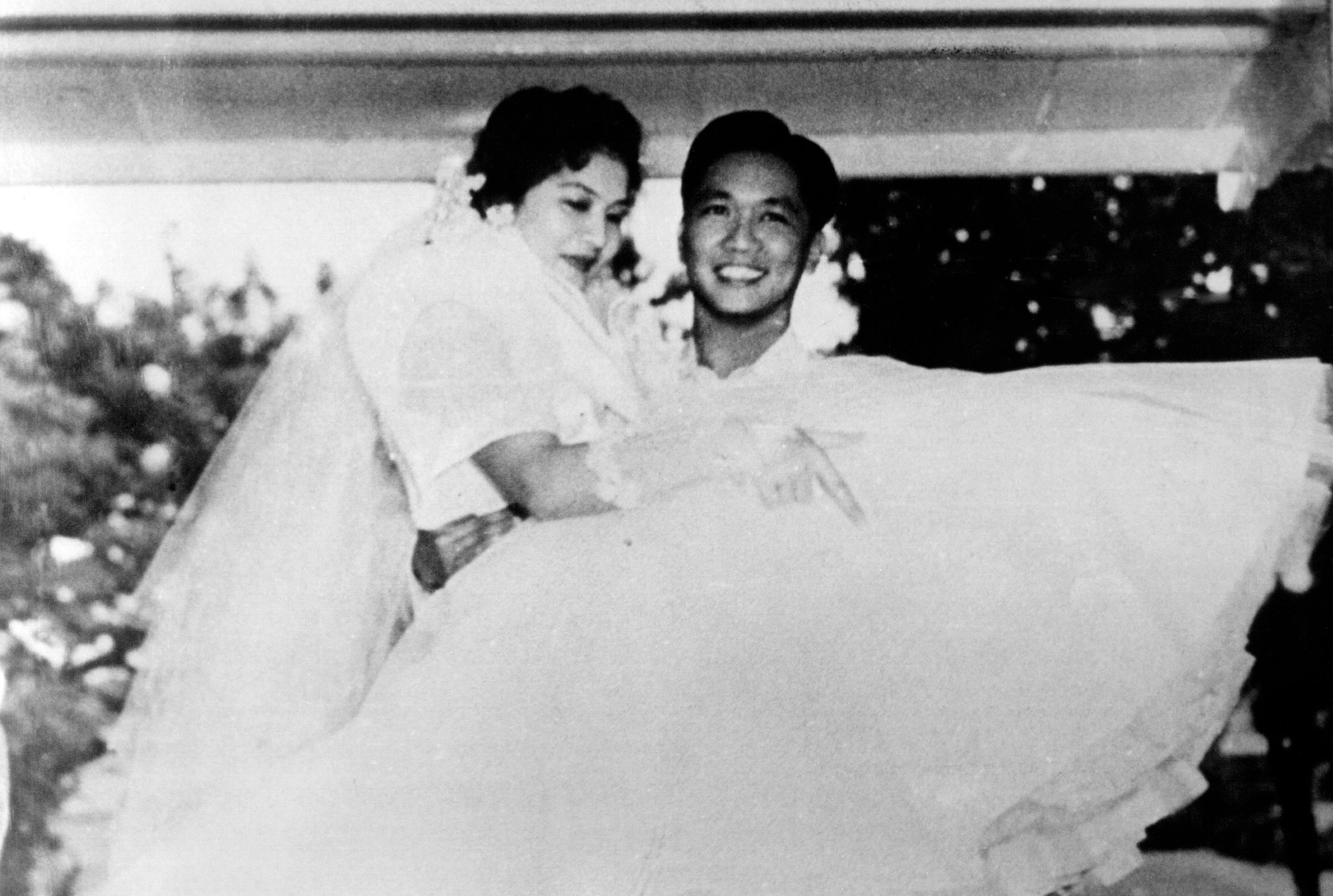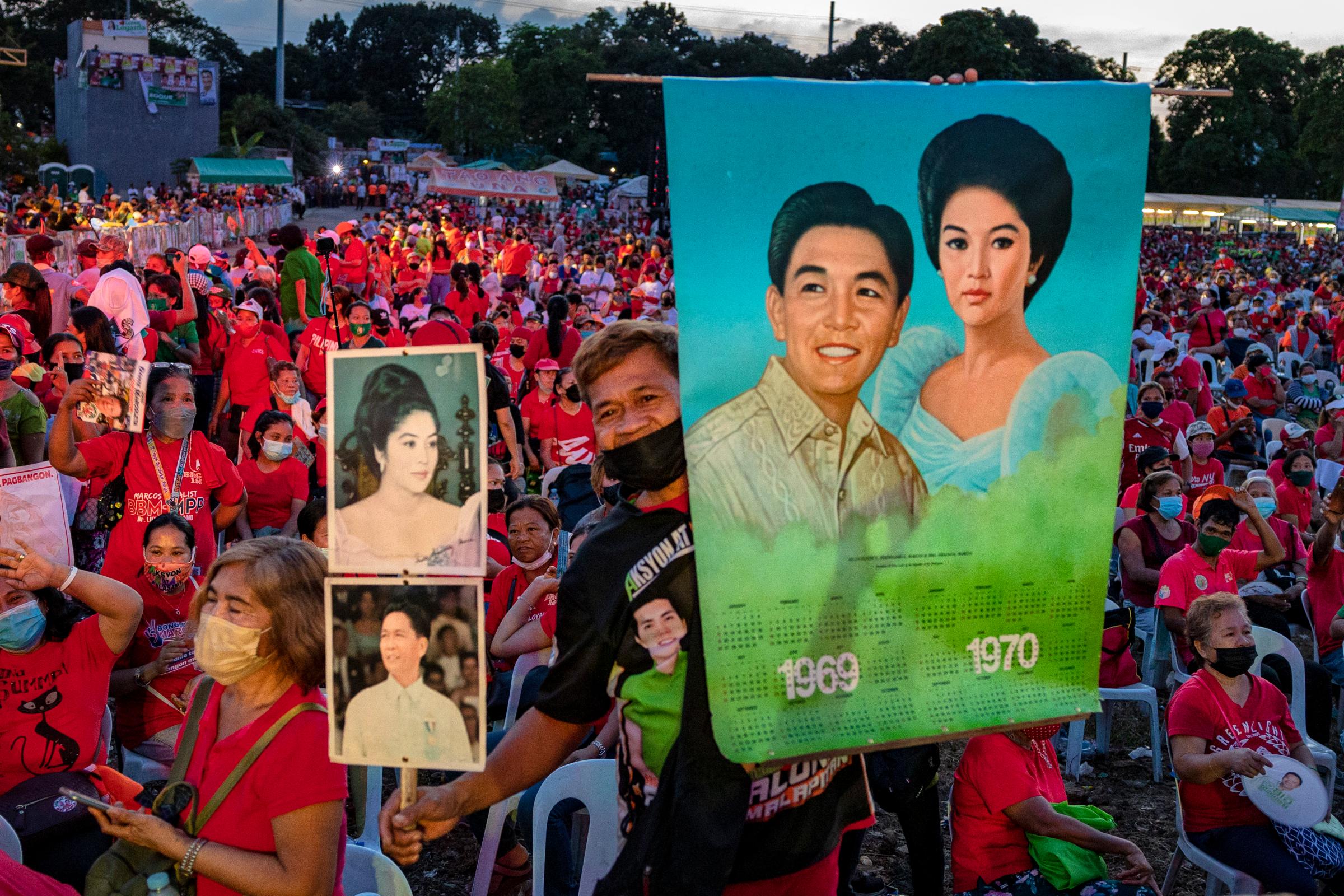“You’re not yet ready to say what your place in history will be,” a reporter for the Philippine version of Playboy magazine said to Ferdinand and Imelda Marcos in 1987, just a year after the former President and first lady had been ousted in a popular revolt. “But how would you want your epitaph to read?”
“Here lies a lawyer,” Ferdinand responded. “Who lies no more,” his wife added. “Who lies still,” he jokingly corrected.
Known less for his sense of humor and more for his rank cronyism and grisly brutality, when Ferdinand died two years later, his eventual gravestone was actually inscribed with just the word “Filipino” beneath his name and years on earth. It was fitting for a man who had certainly left an imprint on the country—though the Philippines would inevitably start to move on without him.
Imelda’s answer to the same interview question, on the other hand, ended up being more enduring: “One word: Love,” she responded in 1987.
Having just turned 94 earlier this month, her legacy, too, is still being written—and on Broadway, sung.
Here Lies Love—a 2010 concept album by Talking Heads frontman David Byrne and musician and producer Fatboy Slim that was first adapted for the stage in 2013—opened at New York’s Broadway Theatre last week. The disco-pop/rock-opera musical chronicles Imelda’s life, from her roots in abject poverty through the fall of her husband’s regime (often described as a conjugal dictatorship) at the hands of the People Power Revolution. Over the years, Byrne has rejected criticisms that his production glorifies Imelda, offering instead that it documents how she “changed over time” and was “corrupted by power.”

It’s certainly not the first time Imelda has been in the spotlight. She’s long been the object of intense cultural fascination, both in the Philippines and around the world, piquing more of a sustained interest than even her late husband or their son, the current President, Ferdinand “Bongbong” Marcos Jr.
“When you think about it, the only true Filipino international celebrity is Imelda Marcos,” historian Ambeth Ocampo tells TIME.
Attention, it seems, has been the currency Imelda has most sought to enrich herself with. Throughout her life, she’s carefully crafted a narrative of beauty and adoration—whether as a rags-to-riches tale of success, a patron of the arts, or a fashion icon—that has ultimately helped to obscure the much uglier reality of complicity, corruption, and criminality that has actually defined her life.
“Perception is real,” Imelda explained in the 2019 documentary The Kingmaker. “The truth is not.”
Here Lies Love leaves out any reference to the one thing most people already know about Imelda: the thousands of shoes she’s amassed, several hundred of which now sit on display in a museum that she helped to open on the outskirts of Manila. Her character in the show, however, does mention not having any shoes when she was young.
“I think the core of Imelda’s character is, of course, she comes from a very poor family. Therefore she cannot have enough of everything,” Tessie Tomas, a veteran Philippine actress known for her satirical impersonations of Imelda, tells TIME.
Indeed, although Imelda was born in 1929 into one of the Philippines’ famed political dynasties, the Romualdezes, a series of misfortunes—her mother died of pneumonia when Imelda was 8 and her father had become nearly bankrupt—led her family to move from Manila to her father’s hometown of Leyte.
But what Imelda’s family lacked in resources, she made up for in beauty, which she wielded as valuable social capital. “Physically, she was always perfection,” says Lauren Greenfield, the documentarian who made The Kingmaker. From a young age, Imelda contested in pageants, first in Leyte then eventually back in Manila, where she convinced the mayor to name her the city’s muse in 1953.
In 1954, during a visit to the capital where her cousin Daniel Romualdez was then Philippine Speaker Pro Tempore of the House of Representatives, Imelda’s good looks caught the eyes of a young congressmember, Ferdinand Marcos. Eleven days later, they were husband and wife.

Imelda didn’t know much about Ferdinand when they married. He had already earned a reputation as a talented lawyer, a self-proclaimed war hero, and a rising political star with his sights set on the highest office in the land. But, according to historical accounts, Imelda was initially repulsed by Ferdinand’s ambitions and the demands politics placed on their life together. She was reluctant to be the “secret weapon,” as he often described her, to his success.
Her aversion changed, however, after she sought treatment for relentless migraines in New York, where doctors reportedly advised that she practice “autosuggestion”—the technique of telling yourself what you want to be true until you believe it. It worked, wrote biographer Kerima Polotan-Tuvera: “Suggestion had become fact. She told herself she was lucky, and she was.”
Imelda emerged from her psychological treatment now eager to climb the ladder with her husband. “I don’t know what life would be without politics,” biographer Katherine Ellison later quoted her saying. Crucially, it seems, Imelda also discovered that if she could shape her own personal narrative for the betterment of her outlook, so too could she engineer a public narrative to promote the advancement of her husband’s career and their collective status.
Together, the two Marcoses embarked on a populist charm offensive, presenting themselves across the archipelago as complementary figures of strength and beauty, as the Southeast Asian nation’s own John Fitzgerald and Jacqueline Kennedy, promising to usher in a new era of governance.

When Ferdinand was first elected to the presidency in 1965, he and Imelda set out to make good on their campaign vow that he would strengthen the Philippines while she would beautify it. A year into Ferdinand’s first term, as he took on the defense portfolio and boosted his influence over the military, Imelda was appointed to lead the development of a Manila cultural center complex, an undertaking for which she justified massive loans to build Brutalist buildings as venues for art, music, and theater. But Imelda’s pet projects—one activist described her as having an “edifice complex”—led the Philippine foreign deficit to skyrocket from millions when Ferdinand was senator in 1962 to billions by the time he was deposed two and a half decades later.
Over the course of their debt-ridden rule, the Marcoses tried to give the impression that their own personal opulence was reflective of the Philippines’ prosperity, but the national economy only worsened, and discontent eventually triggered social unrest. With growing protests from opposition leaders, student groups, and the rural and urban poor, the couple’s power came increasingly under threat—and, by 1972, Ferdinand, having already been elected twice, could not run for a third time. That’s when he declared nationwide martial law, dissolving Congress to consolidate control of government and cracking down on dissent through arbitrary arrests and the shuttering of independent media. It was the start of a nine-year period rife with human rights violations, but it was also the beginning of what would ultimately lead to Ferdinand’s downfall.
As the omnipotent chief executive, Ferdinand could indefinitely extend his and Imelda’s official grip on power, snuffing out political obstacles and opposition. Still, Imelda didn’t want to be seen as merely a dictator’s wife. She was determined to prove that she was nonetheless revered—from staging pageants and boxing matches to distract from the brutality of her husband’s authoritarianism to taking center stage in international diplomacy, hobnobbing with the likes of Richard Nixon, Mao Zedong, and a young then-Prince Charles.
She would also go to great lengths to eliminate any indication that she was not beloved. In 1978, Imelda ranked below well-renowned government critic Benigno “Ninoy” Aquino Jr. in a poll asking university students who their heroes were. Imelda reportedly fumed over the survey results, and military trucks raided the office of the newspaper that was to report on the poll, seizing and destroying all the embarrassing copies. Three years later, in 1981, when 169 people died in the partial collapse of a film center being built at Imelda's cultural center complex, the Marcos administration suppressed reports of the damage and death toll and pushed for the construction to continue apace despite the apparent risks, just so that it would be completed in time for a 1982 film festival that she had been promoting to be the “Cannes of Asia.”

Even as more and more of the Filipino public turned against the Marcos regime, Imelda seemed to tune it out, projecting an image of calm, or even celebration, like everything was actually going just fine. While her country was in shambles, she was caught romping in the infamous New York nightclub Studio 54—which Byrne has credited as the inspiration for the discotheque setting of his musical.
Disaffection with Ferdinand and Imelda reached a turning point with the 1983 assassination of Ninoy, the opposition leader. The couple was rumored to have ordered his killing, which was carried out by the military. While their connection to Ninoy’s murder remains unproven to this day, his death sparked an immense and prolonged backlash against the couple’s autocratic rule.
In a bid to prove that the people of the Philippines still adored him and Imelda, Ferdinand announced a snap election in February 1986. Corazon Aquino, Ninoy’s widow who had become a symbol of a growing pro-democracy movement, ran against him. But the real results weren’t to be known: Ferdinand declared he won with one set of dubious vote counts while his detractors held up another set that showed Corazon on top, amid widespread reports of fraud and tampering.
Ferdinand tried to cling to power, but hundreds of thousands took to the streets, calling for him to step down. Unable to maintain any semblance of legitimacy and fearful of the masses gathering outside the presidential palace gates, on Feb. 25, 1986, Ferdinand, along with Imelda and their children, crammed into a helicopter and fled. When the protesters broke into the palace just hours after it was vacated, they eagerly retrieved what was left behind—symbols and records of their former despots’ profligacy.


Inside, they found numerous expensive artworks including full-length portraits of Ferdinand and Imelda, a multi-million-dollar collection of Imelda’s jewelry, and even uneaten caviar atop the Marcos’ dining table. But garnering the most attention was the discovery of what lay in Imelda’s closet: thousands of shoes.
“They went into my closets looking for skeletons, but thank God all they found were shoes, beautiful shoes,” Imelda would later tell reporters.
Corazon Aquino, who took over as President as soon as Ferdinand left, immediately set out to create a task force to recover the Marcos family’s wealth, deemed stolen from the public—a process that remains unfinished. “There’s been a focus on the shoes,” Andy Bautista, who once led the effort, said in a 2019 Amanpour and Company interview, “but when you think about it, those shoes are really a distraction.”
At the end of Here Lies Love, Philippine revolutionaries band together in celebration of the end of the Marcos dictatorship after Ferdinand and Imelda had decamped from the Philippines for the temporary refuge of Hawaii in 1986. Byrne previously told TIME he’d like those listening to the repertoire of songs he wrote to “reluctantly empathize” with Imelda, although he maintains it’s “not to excuse her” for the starring role she played in the sordid Marcos regime. But no matter how well that effect is achieved, the musical’s neat rise-and-fall arc paints an incomplete picture.

Imelda would not stay in Hawaii for long. After Ferdinand died, she was on a plane in 1991 back to the Philippines, where she was graciously welcomed by supporters at the Manila airport. Also welcoming Imelda were a bevy of charges for alleged embezzlement of public funds. But upon her return from exile, Imelda evaded any real accountability by keeping the focus on her family’s grief. Imelda made it her mission to give her late husband a burial at the Philippine Heroes’ Cemetery—as is customarily granted by sitting Presidents for former Presidents but was denied to the former dictator (until 2016).
When pressed over the years to answer for her family’s crimes, Imelda never bothered too much to defend herself. Instead, she diverted attention to the "sick and misdirected” leadership of the government under Corazon Aquino, from which Imelda said the country needed saving. As formal prosecutions and judgments would take a while, in the interim, Imelda pursued office herself. She ran unsuccessfully for President in 1992, and again in 1998 but withdrew. In 1995, Imelda was elected a congressperson for her hometown Leyte, and in 2010, she was elected to represent Ferdinand’s home province of Ilocos Norte.
Imelda was convicted over two counts of criminal corruption in 1993, but she was acquitted five years later. By the time Imelda faced her latest conviction—for seven counts of graft, each worthy of up to 11 years in prison, for illegally funneling about $200 million to Swiss foundations in the 1970s—it was 2018, and she was 89. The court cited her old age as a factor for bail, and she has since avoided serving any jail time.
Imelda’s seemingly seamless reintegration into Philippine society is in part thanks to a Filipino culture of forgiveness and forgetfulness. In recent years, many voters have expressed a desire to move on from grievances about the past, even electing Marcos Jr. as President in 2022. But the Marcoses’ renewed relevance—and political and cultural clout—is also the product of a deliberate disinformation campaign they’ve waged to whitewash their history.

Imelda has worn many hats—provincial lass, art patron, fashion icon, political matriarch—and her colorful life story has made her a popular subject for everything from songs to movies to books to documentaries to TV parodies to graphic novels to drag impersonations and more. Certainly not every depiction is positive, but the endless cultural preoccupation with Imelda has muddied the simple fact that she’s a convicted criminal—and that underlying the various reputations she cultivated over her lifetime of celebrity was a longstanding complicity in her husband’s dictatorship.
Imelda herself seems pleased to be pictured more in the likes of magazines than in mugshots. When she first listened to the Here Lies Love album in 2010 that would inspire the latest Broadway musical, she took a pair of iPod earbuds out and declared, “I’m flattered!”
“I think we have to be careful with the fetishizing of Imelda Marcos,” says Greenfield, who says when she set out to make The Kingmaker, she thought it would serve as a cautionary tale about the Marcoses. Instead, it became a harbinger of the family’s rehabilitation.
“There is,” the documentarian warns, “a kind of reality-TV…glamorizing of her,” which Greenfield thinks Imelda embraces. “She helps push this narrative of being excessive or indulgent or caring about material things.” But that is, says Greenfield, just a distraction from what Imelda really cares about, which has always been adoration and power.
Ferdinand Marcos “died his country’s greatest villain,” his 1989 obituary in TIME reads. But when Imelda eventually passes too, she likely won’t be remembered as the partner in crime to his villainy that she was, says the historian Ocampo, but rather as the character that she invented in the public’s imagination, the object of fascination: as love—who lies no more, who lies still.
More Must-Reads from TIME
- Cybersecurity Experts Are Sounding the Alarm on DOGE
- Meet the 2025 Women of the Year
- The Harsh Truth About Disability Inclusion
- Why Do More Young Adults Have Cancer?
- Colman Domingo Leads With Radical Love
- How to Get Better at Doing Things Alone
- Michelle Zauner Stares Down the Darkness
Contact us at letters@time.com
